 Handmade lace looks so beautiful. In the 18th and 19th centuries, such lace was one of the main decorative elements for clothing and interior design in Europe. Croatia has a very strong and long-living tradition of lacemaking. These lace samples are delicate, elegant, and skillfully made. Lace is still produced by hand in Croatia but, unfortunately, we can say this craft is dying these days. Croatian youth realizes that they can’t earn a living by making and selling lace. Hurry up to see Croatian splendid handmade lace until you still can.
Handmade lace looks so beautiful. In the 18th and 19th centuries, such lace was one of the main decorative elements for clothing and interior design in Europe. Croatia has a very strong and long-living tradition of lacemaking. These lace samples are delicate, elegant, and skillfully made. Lace is still produced by hand in Croatia but, unfortunately, we can say this craft is dying these days. Croatian youth realizes that they can’t earn a living by making and selling lace. Hurry up to see Croatian splendid handmade lace until you still can.
There are 3 main centers of lacemaking in Croatia, all resting upon a long tradition: the town of Lepoglava in the region of Hrvatsko zagorje, famous for its bobbin lace; the Adriatic island of Pag, with its needle lace; and the city of Hvar, with its aloe lace.
Pag needlepoint lace
Pag is the main town of the Island of Pag, situated in the northern part of the Adriatic. The needlepoint lace of Pag was originally applied on traditional folk costumes – at the front of the female chemise and on the rim of the headgear. The production technique is characterized by the initial particular and strict geometrical patterns. The application of the Pag lace changed over time. It started as trimming on traditional female linen clothing and became later an element of interior decoration of bourgeois houses.
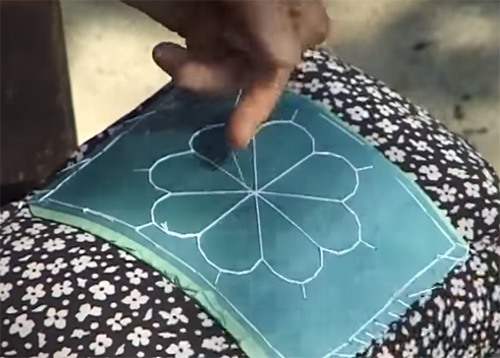
Process of making Pag needlepoint lace
“This is the beginning of making Pag needlepoint lace. At first, you have to make “sinjivanje” – spider web on pattern”, says Urica Orlic, craftswoman and lace maker from Pag.
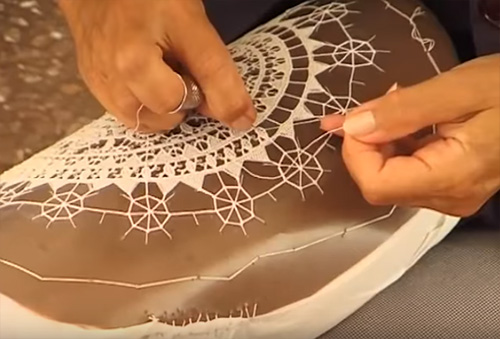
Process of making Pag needlepoint lace
The production of the Pag needlepoint lace requires a small, tightly stuffed semicircular pillow, a needle, and white thread, as well as steady and immaculately clean hands. The pattern, on which small holes trace the contours of the foundation, is fastened to the pillow. A spiderweb is then drawn with the thread to produce the so-called reticulus with loose ends. Each radiating thread is worked with the needle and thread, which results in a firm skeleton. Around these threads, starting from the center, individual patterns are buttonhole stitched in concentric circles.
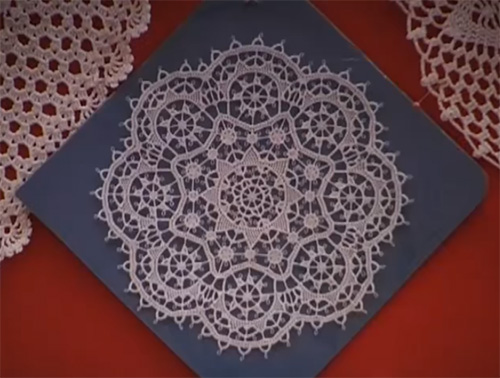
Sample of Croatian traditional lace
Patterns always follow straight geometric forms. Small hollow or full circles, larger circles, triangles, leaves, rhombus, rosettes, zigzag lines, edged by obligatory small circles, etc. In other words, the same ornament is found on the traditional cotton shirts of a folk costume and on a decorative doily, made today.
Lepoglava bobbin lace
Lepoglava – a small town situated in the continental part of Croatia, on the gentle hills of the region of Hrvatsko zagorje. It is believed that the bobbin lace skill was brought to the region of Lepoglava by the monks and the gentry. The lace making technique was taken over by village women, skilled in weaving and embroidery, and used in the production of traditional clothing.
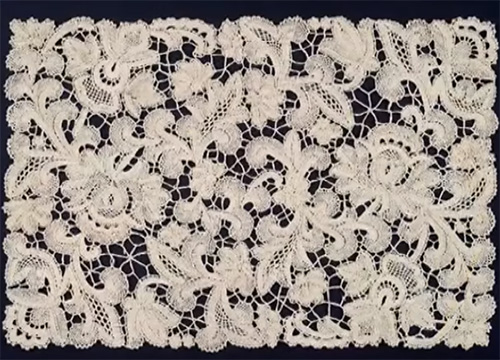
The original Lepoglava lace strip, made of coarse linen thread and applied as trimmings for folk costumes later, developed into fine lace of various shapes and designs, used to decorate the interiors of bourgeois homes or as fashion accessories. These laces are typical for their floral ornaments, taken from traditional textiles and wood carvings.
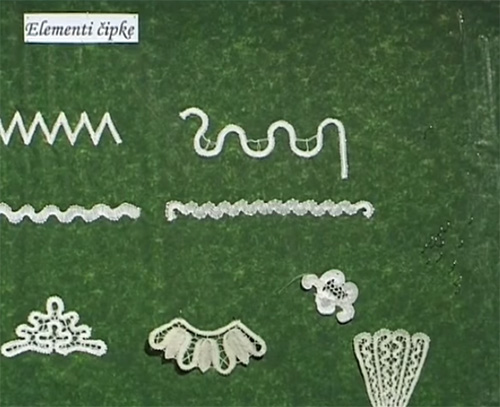
Samples of simple Lepoglava bobbin lace strips
Bobbin lace is made on a tube-shaped hard pillow, resting in a wicker basket, and small wooden sticks – bobbins, around which thread is wound. Always an even number of bobbins are interwoven to produce strips of varying width. They're fixed with pins onto the pillow, producing the desired pattern. The simplest products are strips of varying widths with straight or winding motifs.
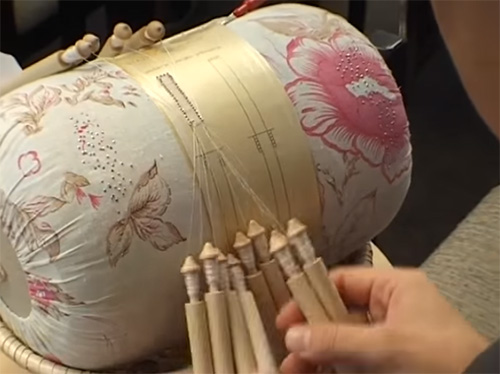
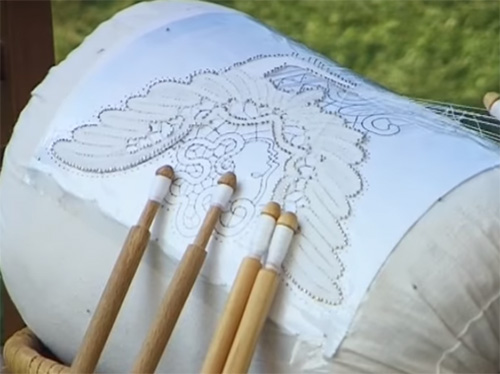
Process of traditional Lepoglava bobbin lacemaking
By pulling the intertwining thread tighter or looser, the density of the thread is determined and the characteristic nuances of the patterns obtained, which is especially striking in floral patterns.

Another interesting element is the varying form of the filling foundation, connecting the decorative motifs. The lace may have bigger or smaller, circular or elongated eyelets.
Hvar aloe lace
Hvar, the main town of the Island of Hvar, is situated in Central Dalmatia. The skill of making aloe lace is the youngest of all traditional lacemaking arts in Croatia. It is made only in the Benedictine Convent of Hvar by applying a special production technique, which includes the painstaking process of obtaining thread from the middle part of the leaves of aloe that grows on the island.

The aloe lace is made without a predetermined pattern or design. There are several techniques to produce aloe lace. One of them is called “circular netting”, where a small sewing needle and a special netting needle are used to produce a pattern of small elongated eyelids worked in circles until the desired size of the doily is reached.
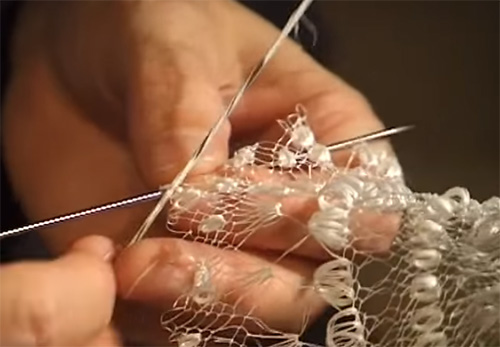
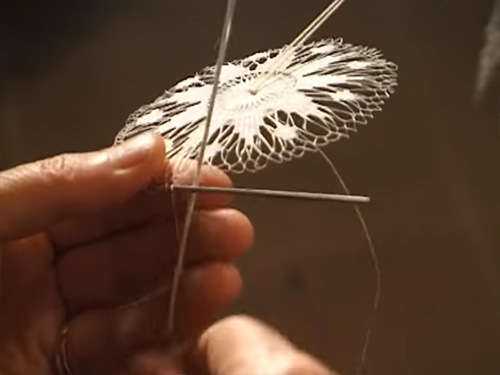
Process of making aloe lace
Another technique is the so-called “Teneriffe”. Teneriffe lace is worked on cardboard with an ordinary needle over a spiderweb of aloe threads to form various geometrical shapes without a predetermined pattern. Various techniques are often combined. Each of the laces is different and unique.
Centuries-old tradition of lacemaking in Croatia
The production of laces in three localities, described above, is rooted in everyday life of the communities and makes them highly recognizable in the cultural mosaic of Croatia.
“Lacemaking in Croatia has centuries-old tradition. It appeared at the same time as in the rest of Europe, where it was made mainly by female religious orders, middle-class women and gentlewomen”, says Nerina Eckhel, museum worker from Ethnographic Museum in Zagreb.
In Croatia, it was passed on by them to peasant women. The technique and design characteristics of such lacework differ from the lacemaking, simultaneously practiced in Europe. Lacemaking in Croatia retained its initial simplicity, using relatively coarse materials, such as a thicker thread, and a limited number of patterns, such as the original reticular and a dozen of geometrical motifs, in the Pag needlepoint lace or the holly stitch and floral ornaments in the Lepoglava bobbin lace. The result of this type of work is all the more admirable because it invests every technique with countless variations producing unique creations of a high technical and artistic value. The aloe laces are also coupling the lacemaking technique with the skill of processing aloe leaves into fine thread.
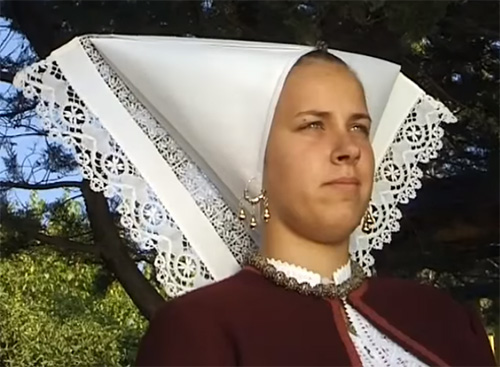
Croatian folk headdress adorned with lace
Lacemaking in Pag, Lepoglava, and Hvar are a unique testimony of a living cultural tradition. The girls of Pag grew up watching their mothers and grandmothers making lace, and learned their first stitches from them. The next encounter with lace was the wearing of the folk costume, which was worn daily in the past but is now worn only on festive occasions. Lace used to be and still is an integral part of church vestments.
In Lepoglava, every newborn girl would be given a bobbin so that she may become a skillful lacemaker. The sound, produced by the wooden bobbins of the mother or grandmother making lace, was often the baby girl’s lullaby. First instructions were received in the parental house, followed by school tuition and lacework courses.
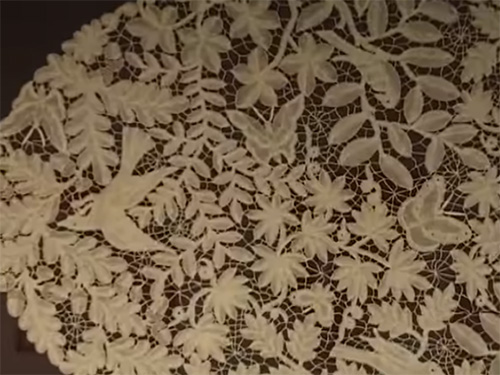
In the specific environment of the common life, the Benedictine Order of Hvar had an additional task for its novices – to learn how to make aloe lace. When transferred to another common, the Hvar nuns often took a piece of lace as a souvenir. But they were never motivated to make another piece of lace in the new environment.
Why Croatian lacemaking is disappearing today
The current situation of lacemaking in Croatia is the result of certain events in the past.
“The industrialization of textile production as early as in the late 19th century. The early 20th century saw migrations of the rural male population in search for jobs, which imposed new obligations for women, leaving them less time to spend on handicrafts”, says Zorica Vitez, PhD, from Institute of Folklore Research in Zagreb.
This has been compounded by the absence of adequate sales channels and the meager remuneration of lace makers, caused by high tax rates. In recent decades, lace has also been suppressed by cheap industrial decorative textiles, imported from other countries. All these developments have led to the total disappearance of lacemaking in most Croatian regions.
The advanced age of active lace makers is the biggest problem and the main threat to the tradition of lacework. Lace production in the Benedictine Convent in Hvar is limited by the small number of the comment’s members. Young generations find little motivation to engage in lacemaking, except for their pleasure of it, especially because they see no possibilities to sell the lacework at reasonable prices.
(c)


